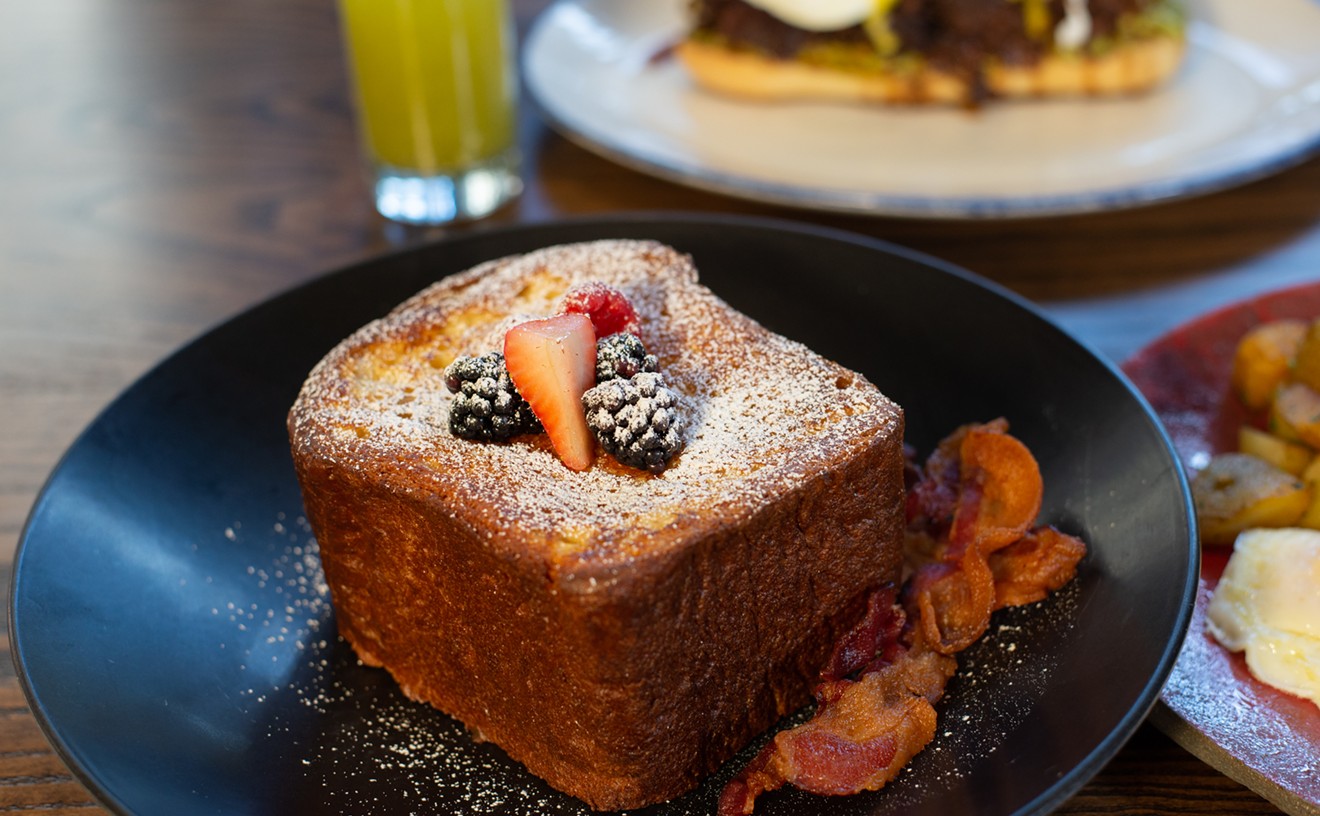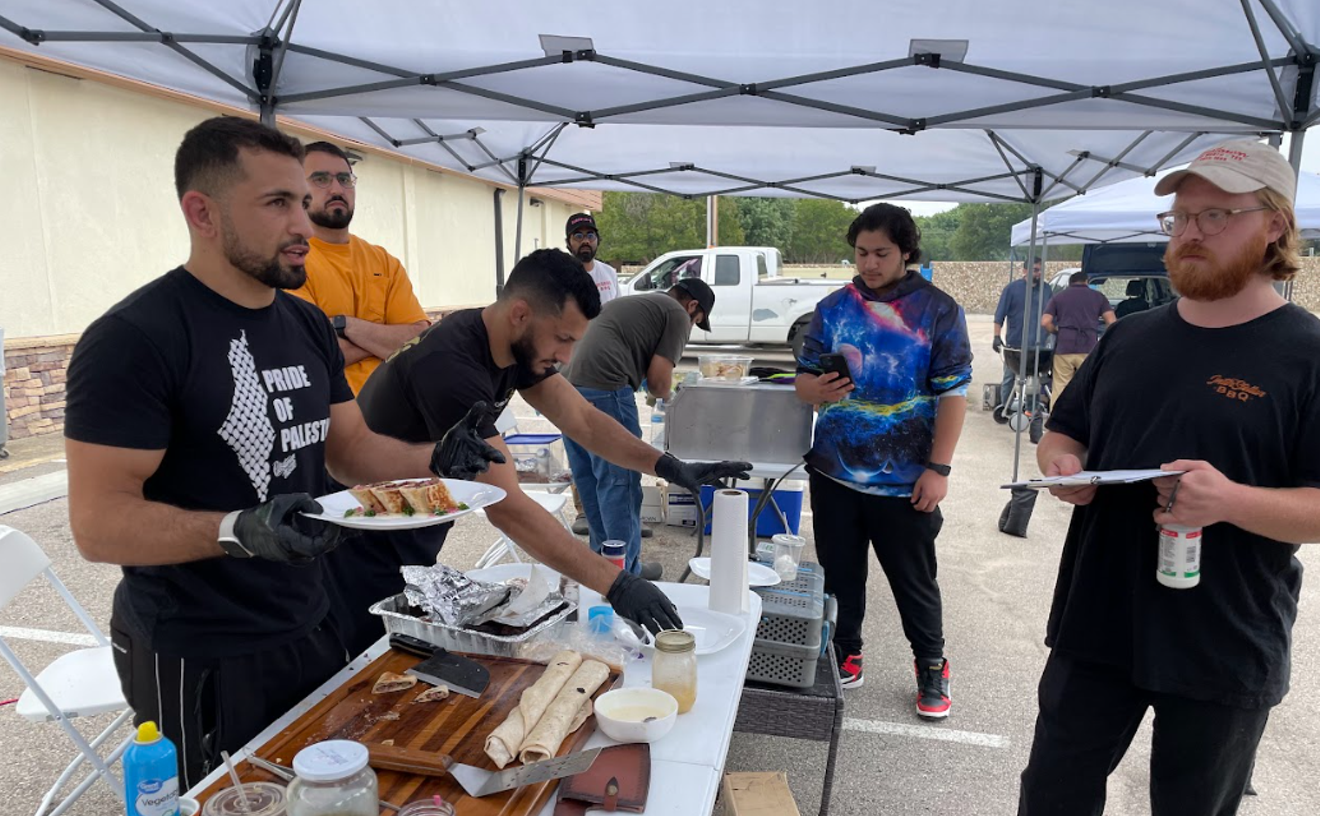It should, because this is a destination if there ever was one. Named for a number that means good luck in much of Asia and for gilled creatures of which they serve a lot, 9 Fish is a fascinating clash of highly disciplined culinary execution and free-wheeling, topsy-turvy protocol. Chef-owner Roy Kamon keeps a fish bowl on the top of his sushi display case in which he keeps a pet beta fish. A sign is taped on the outside of the bowl that reads, "Don't eat me." Kamon says he sometimes prepares sashimi orders in a stemmed glass and inserts it into the beta bowl so that special guests can enjoy their raw fish delicacy while a beta orbits below. What must be shocking and macabre to a pet fish is witty and cutting edge to predatory noshers.
In another display case Kamon keeps an assortment of fish, giant prawns, clams and geoduck--the giant clams from the Pacific Northwest that flaunt 18-inch siphons from their measly 3-inch shells. The protrusions narrowly skirt the horrific, resembling large leathery tongues poised to snatch prey into the suffocating confines of their shells so that it can be slowly digested. More shocking than their appearance is that the geoduck are alive. Really. And if you ask the robata chef, a bald Thai fellow named Johnny, he'll prove it by reaching into the case and slapping the clam siphons, causing them to wiggle like slugs anticipating a salt shake.
The geoduck are served either skewered with pineapple (chewy and smoky) from the robata grill, or raw as sushi. The latter is the more interesting presentation, a pair of thin, semitransparent shavings of clam draped on rice cushions. The meat is chewy and pleasantly briny, tickling the palate with its ripe, sea-spray muskiness.
Why Frisco? "That's a question that people keep asking me," Kamon says. But after spending some eight years plying his trade in South Beach, Florida, Kamon evacuated that tropical haunt, dragging a couple of his chefs with him, because the stress of surviving day to day in the harsh climate of incessant trend-setting wore him down. He settled in Frisco because he couldn't afford the rich lease rates of Dallas real estate. Yet in Frisco, he says, the population avoids him, habitually linked as it is to the chain-restaurant culture, where waits are short and grub doesn't come with leering pets as a side item. "It's kinda hard to get people in Frisco to come out here," he laments. "Most of my customers come from Dallas, north Plano and a lot from Highland Park. I'm surprised at how many people come from over there."
I guess this proves that people will put up with road snarls and endless ribbons of asphalt if the raw fish tastes like it surfed on a rice pad from the ocean to your tongue. And here it does. The tuna and hamachi are fresh, cool, firm and silky, without any sinuous strands to get tangled between your crowns. The flesh literally dissolves between your cheeks.
Visual flourishes infect the presentation, too. The white tuna is centerpieced with tiny pinches of greens coddling bits of diced tomato. The toro, marbled tuna that could pass for pricey beef in dim light, arrives with a diminutive flower huddled between the wasabi and the pickled ginger.
Kamon also makes promiscuous use of martini glasses, a visual cue of cool if there ever was one. The spicy tuna tartar salad is a silo constructed out of tiny tuna cubes mortared together with sesame oil, ponzu sauce and quail egg. Planted in the top of the silo is a crispy fish chip, leaning past the edge of the glass like a sail. It's founded on a slightly wilted pinch of greens stuffed into the throat of the glass. The flavors were remarkable, though the fish was a bit warmer than is comfortable for raw fish.
Pan-fried ankimo, or Japanese foie gras as it's designated on the menu, is also silo-shaped and topped with a seaweed and teardrop tomato salad. The monkfish liver is slightly singed on the outside with a cool and gelatinous interior. The flavor is ripe and seaworthy, like the raw geoduck, only much more intense.
Kamon says his fish behaves so well in the mouth because everything he uses, whether grilled or served raw, is the top grade of fish available. "It doesn't have that old smell to it," he boasts. Thank God for smell favors.
The giant prawn was tossed and turned on the robata grill before it made its way to a martini glass, its antennae coiling over the glass edge. It was a rich thing, behaving in the mouth more like lobster meat than something related to a Red Lobster popcorn prawn. And though the long, thin spiny claws posed innumerable hazards, pricking the fingers like thistle fuzz, the thin strips of meat were nearly as good as the succulent tail chunks.
9 Fish's robata bar is a unique piece of architecture. Wedged next to the sushi bar, the grill is enclosed with sheets of tempered glass, the edges bandaged with frayed strips of thin silvery tape. The skewered morsels are gently soaked with smoke, giving the rib eye cubes with mushroom a distinct richness you can't get by fumigating a whole steak with mesquite or hickory. Kamon intersperses bits of robata-ized salmon with severed orange sections on the skewer.
He says he likes to experiment with sauces, ejecting butter and cream and injecting fruit and wine. This tendency is most apparent in the entrées, which include salmon marinated in ginger and chardonnay and chicken breast marinated in soy and garnished with grilled pineapple and a poached apple. The chicken was refreshing and flavorful but slightly dry. Much better was the peppered tuna perched on black sticky rice and "escorted by fresh field greens." It arrives as two tall pink wedges that rise out of the dark rice like coastal palisades. In the mouth the fish behaves like pristine slivers of ocean silk.
The atmosphere at 9 Fish is spartan and cool, with a stained concrete floor and a ceiling with exposed guts. Yet the room is still warm, inviting and spontaneous, mostly thanks to a waitstaff that is as attentive and gracious as it is knowledgeable. But there are other factors. On weekends, a corner of the dining room floor is devoted to live jazz. The music on one weekend evening got so infectious that Johnny the robata chef threw down his skewer, picked up a guitar and joined the jam, bending strings and grimacing like Carlos Santana hopped up on geoduck. The pet fish isn't the only crazy thing at 9 Fish. That makeshift tempered glass robata grill must really concentrate the smoke.










